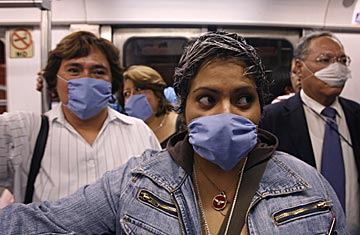
Subway riders in Mexico City wear surgical masks to avoid catching the flu, Friday, April 24.
(2 of 4)
1. Is this a flu pandemic?
The influenza virus is constantly mutating. That's why we can't get full immunity to the flu, the way we can to diseases like chicken pox, because there are multiple strains of the flu virus and they change from year to year. However, even though the virus makes us sick, our immune systems can usually muster enough of a response so that the flu is rarely fatal for healthy people.
But every once in awhile, the virus shifts its genetic structure so much that our immune systems offer no protection whatsoever. (This usually happens when a flu virus found in animals — like the avian flu still circulating in Asia — swaps genes with other viruses in a process called reassortment, and jumps to human beings.) A flu pandemic occurs when a new flu virus emerges for which humans have little or no immunity and then spreads easily from person to person around the world. In the 20th century we had two mild flu pandemics, in 1968 and 1957, and the severe "Spanish flu" pandemic of 1918, which killed an estimated 40 to 50 million people worldwide.
The WHO has the responsibility of declaring when a new flu pandemic is underway, and to simplify the process, the U.N. body has established six pandemic phases. Thanks to H5N1 avian flu, which has killed 257 people since 2003 but doesn't spread very well from one human to another, we're currently at phase 3. If the WHO upgraded that status to phase 4, which is marked by a new virus that begins to pass easily enough from person to person that we can detect community-sized outbreaks, such a move would effectively mean that we've got a pandemic on our hands.
The H1N1 swine flu virus has already been identified as a new virus, with genes from human and avian flus as well as the swine variety. And since it is apparently causing large-scale outbreaks in Mexico, along with separate confirmed cases in the U.S. and Canada and suspected cases in other countries, it would seem that we've already met the criteria for phase 4. But though an emergency committee met on April 25 to evaluate the situation, the WHO hasn't made the pandemic declaration yet. Keiji Fukuda, the WHO's interim assistant director-general for health, security and environment, said on Sunday that its experts "would like a little bit more information and a little bit more time to consider this." The committee is set to meet again by April 28 at the latest.
As health officials have repeatedly emphasized, with good reason, the swine flu situation is evolving rapidly, and more lab tests are needed to ascertain exactly what is going on in Mexico and elsewhere. "We want to make sure we're on solid ground," said Fukuda, a highly respected former CDC official and flu expert.
2. What will happen if this outbreak gets classified as a pandemic?
Moving the world to pandemic phase 4 would be the signal for serious containment actions to be taken on the national and international level. Given that these actions would have major implications for the global economy, not to mention the effects of the public fear that would ensue, there is concern that the WHO may be considering politics along with science. "What the WHO did makes no sense," says Osterholm. "In a potential pandemic, you need to have the WHO be beyond question, and (April 25) was not a good day for them."
Of course, declaring a pandemic isn't a decision that should be taken lightly. For the WHO, phase 4 might trigger an attempt to keep the virus from spreading by instituting strict quarantines and blanketing infected areas with antivirals. But we appear to have missed the opportunity to contain the disease at its source since the virus is already crossing borders with ease. "We cannot stop this at the border," said Anne Schuchat, the CDC's interim director for science and public health. "We don't think that we can quench this in Mexico if it's in many communities now."
See the world's most influential people in the 2009 TIME 100.
